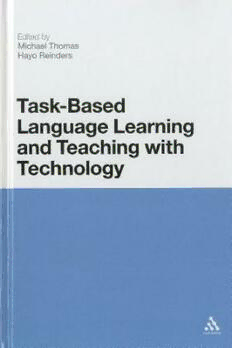
Task-Based Language Learning and Teaching with Technology PDF
Preview Task-Based Language Learning and Teaching with Technology
Task-Based Language Learning and Teaching with Technology Also available from Continuum Online Second Language Acquisition, Vincenza Tudini Teacher Cognition and Language Education, Simon Borg Task-Based Language Learning and Teaching with Technology Edited by Michael Thomas and Hayo Reinders Continuum International Publishing Group The Tower Building 80 Maiden Lane 11 York Road Suite 704 London SE1 7NX New York, NY 10038 www.continuumbooks.com © Michael Thomas, Hayo Reinders and contributors 2010 All rights reserved. No part of this publication may be reproduced or transmitted in any form or by any means, electronic or mechanical, including photocopying, recording, or any information storage or retrieval system, without prior permission in writing from the publishers. Michael Thomas and Hayo Reinders have asserted their right under the Copyright, Designs and Patents Act, 1988, to be identifi ed as Authors of this work. British Library Cataloguing-in-Publication Data A catalogue record for this book is available from the British Library. ISBN: 978-1-4411-0153-2 (hardcover) Library of Congress Cataloging-in-Publication Data Task-based language learning and teaching with technology / edited by Michael Thomas and Hayo Reinders. p. cm. Includes bibliographical references and index. ISBN 978-1-4411-0153-2 (hardback) 1. Language and languages--Computer-assisted instruction. I. Thomas, Michael, 1969- II. Reinders, Hayo. III. Title. P53.28.T38 2010 418.0078'5--dc22 2009051951 Typeset by Newgen Imaging Systems Pvt Ltd, Chennai, India Printed and bound in Great Britain by the MPG Books Group Contents List of Figures and Tables vii Notes on Contributors x Foreword by Rod Ellis xvi List of Abbreviations xix Chapter 1: Deconstructing Tasks and Technology 1 Michael Thomas and Hayo Reinders Part I: Research on Tasks in CALL Chapter 2: Research on the Use of Technology in Task-Based Language Teaching 17 Andreas Müller-Hartmann and Marita Schocker-v. Ditfurth Chapter 3: T ask-Based Language Teaching in Network-Based CALL: An Analysis of Research on Learner Interaction in Synchronous CMC 41 Mark Peterson Chapter 4: Taking Intelligent CALL to Task 63 Mathias Schulze Chapter 5: Effects of Multimodality in Computer-Mediated Communication Tasks 83 Glenn Stockwell vi Contents Chapter 6: Measuring Complexity in Task-Based Synchronous Computer-Mediated Communication 105 Karina Collentine Part II: Applying Technology-Mediated Tasks Chapter 7: Task Design for a Virtual Learning Environment in a Distance Language Course 131 Regine Hampel Chapter 8: Teacher Development, TBLT and Technology 154 Thomas Raith and Volker Hegelheimer Chapter 9: Edubba: Real-World Writing Tasks in a Virtual World 176 Kenneth Reeder Chapter 10: The Enactment of Task Design in Telecollaboration 2.0 197 Mirjam Hauck Chapter 11: Afterword: Future Directions for Technology- Mediated Tasks 218 Gary Motteram and Michael Thomas Index 239 List of Figures and Tables Figures Figure 2.1 Activity system (based on Engeström et al., 1999) 22 Figure 6.1 Sample treatment screen 114 Figure 6.2 N ominal cluster: Descriptive statistics of summed z-scores by task and learner level 117 Figure 6.3 N arrative cluster: Descriptive statistics of summed z-scores by task and learner level 119 Figure 6.4 P ropositional complexity cluster: Descriptive statistics of summed z-scores by task and learner level 121 Figure 6.5 O verlay of screens with timer bar and iChat directions 123 Figure 9.1 Edubba’s virtual characters 178 Figure 9.2 Edubba’s conceptual design 179 Figure 9.3 The virtual city 180 Figure 9.4 The pedagogical model of writing in Edubba 191 Figure 10.1 Project Task 1 208 Figure 10.2 Proje ct Task 1, Part 3 new 211 Figure 10.3 2009 exchange – Task 2, Part 3 213 Figure 11.1 Needs analysis viewed through an activity theory lens 223 Figure 11.2 The hexagon model of synchronous teaching methodology 224 Figure 11.3 A model for implementing tasks in Second Life from Deutschmann (2009) 227 viii List of Figures and Tables Tables Table 3.1 Potential advantages and limitations of interaction in text-based real-time CMC for language learners 47 Table 3.2 K ey fi ndings of studies on learner interaction in LAN-based CMC 50 Table 3.3 K ey fi ndings of studies on learner interaction in chat-based CMC 53 Table 3.4 K ey fi ndings of studies on learner interaction in chat-based CMC 56 Table 5.1 S tudents participating in the classes according to year 91 Table 5.2 M ean number of words per chat session/ forum post 93 Table 5.3 M ean TTR for each chat session/forum post 94 Table 5.4 P ercentage of correctly spelt words in each chat session/forum post 94 Table 5.5 M ean length of c-unit for each chat session/ forum post 95 Table 5.6 P ercentage of error-free c-units for each chat session/forum post 95 Table 6.1 N ominal cluster: descriptive statistics of summed z-scores by task and learner level 117 Table 6.2 N ominal cluster: signifi cance tests of summed z-scores 118 Table 6.3 Narrative cluster: descriptive statistics of summed z-scores by task and learner level 119 Table 6.4 Narrative cluster: signifi cance tests of summed z-scores 119 Table 6.5 Propositional complexity cluster: descriptive statistics of summed z-scores by task and learner level 121 Table 6.6 Propositional complexity cluster: Signifi cance tests of summed z-scores 121 Table 7.1 T ask framework 140 Table 7.2 A dditional dimensions of the task framework 141 Table 7.3 R ealization of Ellis’s and Oxford’s task features in online design 142 List of Figures and Tables ix Table 8.1 Standards-based model of task-based teaching competencies 162 Table 8.2 L evels of task refl ection 165 Table 9.1 G enres and thinking skills in Edubba 184 Table 9.2 ‘ To-Do’ list for student interns’ orientation 186 Table 9.3 ‘ Task vs. Exercise’ learning activities 187 Table 9.4 ‘ To-Do’ list for staff reporters’ story 1 188 Table 10.1 Participant groups 202 Table 10.2 Project plan 203
